Highly Selective and Reproducible Electrochemical Sensing of Ascorbic Acid Through a Conductive Polymer Coated Electrode
Abstract
1. Introduction
2. Experimental
2.1. Chemicals
2.2. Instrumentation
2.3. Cleaning of the Au-disc Electrode
2.4. Fabrication of the Modified PANI Electrode
2.5. Preparation of the AA Solutions
3. Results and Discussions
3.1. Electropolymerization of Aniline
3.2. FTIR Analysis
3.3. SEM Analysis
3.4. Thermal Analysis
3.5. Effective Area of PANI Modified Electrode
3.6. Ascorbic Acid (AA) Sensing by PANI
3.7. pH and Scan Rate Effect on AA oxidation
3.8. Effect of AA Concentration on Voltammetric Response of the PANI Modified Electrode
3.9. Chronoamperometry
3.10. Reproducibility of AA Sensor
4. Conclusions
Author Contributions
Funding
Acknowledgments
Conflicts of Interest
References
- Castillo-Ortega, M.; Del Castillo-Castro, T.; Ibarra-Bracamontes, V.; Nuno-Donlucas, S.; Puig, J.; Herrera-Franco, P. Urea sensing film prepared by extrusion from DBSA-doped polyaniline-poly (styrene-co-potassium acrylate) in a poly (n-butyl methacrylate) matrix. Sens. Actuators B Chem. 2007, 125, 538–543. [Google Scholar] [CrossRef]
- Pei, L.; Qiu, F.; Ma, Y.; Lin, F.; Fan, C.; Ling, X.; Zhu, S. Graphene/zinc bismuthate nanorods composites and their electrochemical sensing performance for ascorbic acid. Fuller. Nanotub. Carbon Nanostruct. 2019, 27, 58–64. [Google Scholar] [CrossRef]
- Erdurak-Kilic, C.; Uslu, B.; Dogan, B.; Ozgen, U.; Ozkan, S.; Coskun, M. Anodic voltammetric behavior of ascorbic acid and its selective determination in pharmaceutical dosage forms and some Rosa species of Turkey. J. Anal. Chem. 2006, 61, 1113–1120. [Google Scholar] [CrossRef]
- Xing, L.; Ma, Z. A glassy carbon electrode modified with a nanocomposite consisting of MoS2 and reduced graphene oxide for electrochemical simultaneous determination of ascorbic acid, dopamine, and uric acid. Microchim. Acta 2016, 183, 257–263. [Google Scholar] [CrossRef]
- Syed, A.A.; Knowlson, S.; Sculthorpe, R.; Farthing, D.; DeWilde, C.; Farthing, C.A.; Larus, T.L.; Martin, E.; Brophy, D.F.; Gupta, S. Phase I safety trial of intravenous ascorbic acid in patients with severe sepsis. J. Transl. Med. 2014, 12, 1–10. [Google Scholar] [CrossRef]
- Pakapongpan, S.; Mensing, J.P.; Phokharatkul, D.; Lomas, T.; Tuantranont, A. Highly selective electrochemical sensor for ascorbic acid based on a novel hybrid graphene-copper phthalocyanine-polyaniline nanocomposites. Electrochim. Acta 2014, 133, 294–301. [Google Scholar] [CrossRef]
- Pisoschi, A.M.; Pop, A.; Serban, A.I.; Fafaneata, C. Electrochemical methods for ascorbic acid determination. Electrochim. Acta 2014, 121, 443–460. [Google Scholar] [CrossRef]
- Kishida, E.; Nishimoto, Y.; Kojo, S. Specific determination of ascorbic acid with chemical derivatization and high-performance liquid chromatography. Anal. Chem. 1992, 64, 1505–1507. [Google Scholar] [CrossRef]
- Agater, I.B.; Jewsbury, R.A. Direct chemiluminescence determination of ascorbic acid using flow injection analysis. Anal. Chim. Acta 1997, 356, 289–294. [Google Scholar] [CrossRef]
- Yebra, M.; Cespon, R.; Moreno-Cid, A. Automatic determination of ascorbic acid by flame atomic absorption spectrometry. Anal. Chim. Acta 2001, 448, 157–164. [Google Scholar] [CrossRef]
- Ponnaiah, S.K.; Periakaruppan, P.; Vellaichamy, B. New Electrochemical Sensor Based on a Silver-Doped Iron Oxide Nanocomposite Coupled with Polyaniline and Its Sensing Application for Picomolar-Level Detection of Uric Acid in Human Blood and Urine Samples. J. Phys. Chem. B 2018, 122, 3037–3046. [Google Scholar] [CrossRef]
- Yusoff, N.; Pandikumar, A.; Ramaraj, R.; Lim, H.N.; Huang, N.M. Gold nanoparticle based optical and electrochemical sensing of dopamine. Microchim. Acta 2015, 182, 2091–2114. [Google Scholar] [CrossRef]
- Kudr, J.; Nguyen, H.; Gumulec, J.; Nejdl, L.; Blazkova, I.; Ruttkay-Nedecky, B.; Hynek, D.; Kynicky, J.; Adam, V.; Kizek, R. Simultaneous Automatic Electrochemical Detection of Zinc, Cadmium, Copper and Lead Ions in Environmental Samples Using a Thin-Film Mercury Electrode and an Artificial Neural Network. Sensors 2015, 15, 592–610. [Google Scholar] [CrossRef]
- Zhang, X.; Lai, G.; Yu, A.; Zhang, H. A glassy carbon electrode modified with a polyaniline doped with silicotungstic acid and carbon nanotubes for the sensitive amperometric determination of ascorbic acid. Microchim. Acta 2013, 180, 437–443. [Google Scholar] [CrossRef]
- Jadon, N.; Jain, R.; Sharma, S.; Singh, K. Recent trends in electrochemical sensors for multianalyte detection—A review. Talanta 2016, 161, 894–916. [Google Scholar] [CrossRef]
- Park, S.; Park, C.; Yoon, H. Chemo-electrical gas sensors based on conducting polymer hybrids. Polymers 2017, 9, 155. [Google Scholar] [CrossRef]
- Sabatini, V.; Pifferi, V.; Checchia, S.; Rebeccani, S.; Farina, H.; Aldo Ortenzi, M.; Falciola, L. A Combined XRD, Solvatochromic, and Cyclic Voltammetric Study of Poly (3, 4-Ethylenedioxythiophene) Doped with Sulfonated Polyarylethersulfones: Towards New Conducting Polymers. Polymers 2018, 10, 770. [Google Scholar] [CrossRef]
- Janata, J.; Josowicz, M. Conducting polymers in electronic chemical sensors. Nat. Mater. 2003, 2, 19–24. [Google Scholar] [CrossRef]
- Fratoddi, I.; Venditti, I.; Cametti, C.; Russo, M.V. Chemiresistive polyaniline-based gas sensors: A mini review. Sens. Actuator B Chem. 2015, 220, 534–548. [Google Scholar] [CrossRef]
- Prathap, M.A.; Srivastava, R. Tailoring properties of polyaniline for simultaneous determination of a quaternary mixture of ascorbic acid, dopamine, uric acid, and tryptophan. Sens. Actuator B Chem. 2013, 177, 239–250. [Google Scholar] [CrossRef]
- Ghanbari, K.; Moloudi, M. Flower-like ZnO decorated polyaniline/reduced graphene oxide nanocomposites for simultaneous determination of dopamine and uric acid. Anal. Biochem. 2016, 512, 91–102. [Google Scholar] [CrossRef]
- Sen, T.; Mishra, S.; Shimpi, N.G. Synthesis and sensing applications of polyaniline nanocomposites: A review. RSC Adv. 2016, 6, 42196–42222. [Google Scholar] [CrossRef]
- Das, M.; Sarkar, D. One-pot synthesis of zinc oxide-polyaniline nanocomposite for fabrication of efficient room temperature ammonia gas sensor. Ceram Int. 2017, 43, 11123–11131. [Google Scholar] [CrossRef]
- Ambrosi, A.; Morrin, A.; Smyth, M.R.; Killard, A.J. The application of conducting polymer nanoparticle electrodes to the sensing of ascorbic acid. Anal. Chim. Acta 2008, 609, 37–43. [Google Scholar] [CrossRef]
- Rana, U.; Paul, N.D.; Mondal, S.; Chakraborty, C.; Malik, S. Water soluble polyaniline coated electrode: A simple and nimble electrochemical approach for ascorbic acid detection. Synth Met. 2014, 192, 43–49. [Google Scholar] [CrossRef]
- Bhadra, S.; Khastgir, D.; Singha, N.K.; Lee, J.H. Progress in preparation, processing and applications of polyaniline. Prog. Polym. Sci. 2009, 34, 783–810. [Google Scholar] [CrossRef]
- Li, G.-R.; Feng, Z.-P.; Zhong, J.-H.; Wang, Z.-L.; Tong, Y.-X. Electrochemical synthesis of polyaniline nanobelts with predominant electrochemical performances. Macromolecules 2010, 43, 2178–2183. [Google Scholar] [CrossRef]
- Fischer, L.M.; Tenje, M.; Heiskanen, A.R.; Masuda, N.; Castillo, J.; Bentien, A.; Émneus, J.; Jakobsen, M.H.; Boisen, A. Gold cleaning methods for electrochemical detection applications. Microelectron. Eng. 2009, 86, 1282–1285. [Google Scholar] [CrossRef]
- Nguyen, T.H.; Venugopala, T.; Chen, S.; Sun, T.; Grattan, K.T.; Taylor, S.E.; Basheer, P.M.; Long, A.E. Fluorescence based fibre optic pH sensor for the pH 10–13 range suitable for corrosion monitoring in concrete structures. Sens. Actuator B Chem. 2014, 191, 498–507. [Google Scholar] [CrossRef]
- Singh, K.; Ohlan, A.; Kotnala, R.; Bakhshi, A.; Dhawan, S. Dielectric and magnetic properties of conducting ferromagnetic composite of polyaniline with γ-Fe2O3 nanoparticles. Mater. Chem. Phys. 2008, 112, 651–658. [Google Scholar] [CrossRef]
- Raj, J.A.; Mathiyarasu, J.; Vedhi, C.; Manisankar, P. Electrochemical synthesis of nanosize polyaniline from aqueous surfactant solutions. Mater. Lett. 2010, 64, 895–897. [Google Scholar] [CrossRef]
- Cao, P.-F.; Mangadlao, J.D.; Advincula, R.C. Stimuli-responsive polymers and their potential applications in oil-gas industry. Polym. Rev. 2015, 55, 706–733. [Google Scholar] [CrossRef]
- Arasi, A.Y.; Jeyakumari, J.J.L.; Sundaresan, B.; Dhanalakshmi, V.; Anbarasan, R. The structural properties of Poly (aniline)—Analysis via FTIR spectroscopy. Spectrochim. Acta A Mol. Biomol. Spectrosc. 2009, 74, 1229–1234. [Google Scholar] [CrossRef] [PubMed]
- Das, M.; Sarkar, D. Effect of oxidizing agent on ammonia sensing of DBSA doped polyaniline nanocomposite thin film. J. Mater. Sci. Mater. Electron. 2016, 27, 4109–4119. [Google Scholar] [CrossRef]
- Selvanayagam, A.S.; Jeyaprakash, B.; Rayappan, J.B.B. Preparation, characterization and chemical sensing properties of polyaniline thin films. J. Appl. Sci. 2012, 12, 1710–1713. [Google Scholar] [CrossRef][Green Version]
- Silva, A.; Ugucioni, J.; Correa, S.; Ardisson, J.; Macedo, W.; Silva, J.; Cotta, A.; Brito, A. Synthesis and characterization of nanocomposites consisting of polyaniline, chitosan and tin dioxide. Mater. Chem. Phys. 2018, 216, 402–412. [Google Scholar] [CrossRef]
- Trchova, M.; Sedenkova, I.; Tobolkova, E.; Stejskal, J. FTIR spectroscopic and conductivity study of the thermal degradation of polyaniline films. Polym. Degrad. Stab. 2004, 86, 179–185. [Google Scholar] [CrossRef]
- Gul, S.; Shah, A.U.; Bilal, S. Effect of high temperature on the electrochemical and optical properties of emeraldine salt doped with DBSA and sulfuric acid. J. Chem. 2015, 2015, 1–9. [Google Scholar] [CrossRef]
- Mondal, S.; Sangaranarayanan, M. A novel non-enzymatic sensor for urea using a polypyrrole-coated platinum electrode. Sens. Actuator B Chem. 2013, 177, 478–486. [Google Scholar] [CrossRef]
- Ansari, M.O.; Mohammad, F. Thermal stability, electrical conductivity and ammonia sensing studies on p-toluenesulfonic acid doped polyaniline: Titanium dioxide (pTSA/Pani: TiO2) nanocomposites. Sens. Actuator B Chem. 2011, 157, 122–129. [Google Scholar] [CrossRef]
- Shi, J.; Claussen, J.C.; McLamore, E.S.; ul Haque, A.; Jaroch, D.; Diggs, A.R.; Calvo-Marzal, P.; Rickus, J.L.; Porterfield, D.M. A comparative study of enzyme immobilization strategies for multi-walled carbon nanotube glucose biosensors. Nanotechnology 2011, 22, 355502. [Google Scholar] [CrossRef] [PubMed]
- Singhal, C.; Malhotra, N.; Pundir, C.; Narang, J. An enzyme free vitamin C augmented sensing with different ZnO morphologies on SnO2/F transparent glass electrode: A comparative study. Mater. Sci. Eng. C 2016, 69, 769–779. [Google Scholar] [CrossRef] [PubMed]
- Ruiz, J.J.; Aldaz, A.; Dominguez, M. Mechanism of L-ascorbic acid oxidation and dehydro-L-ascorbic acid reduction on a mercury electrode. I. Acid medium. Can. J. Chem. 1977, 55, 2799–2806. [Google Scholar] [CrossRef]
- Kalakodimi, R.P.; Nookala, M. Electrooxidation of ascorbic acid on a polyaniline-deposited nickel electrode: Surface modification of a non-platinum metal for an electrooxidative analysis. Anal. Chem. 2002, 74, 5531–5537. [Google Scholar] [CrossRef] [PubMed]
- Xu, H.; Xiao, J.; Yan, L.; Zhu, L.; Liu, B. An electrochemical sensor for selective detection of dopamine based on nickel tetrasulfonated phthalocyanine functionalized nitrogen-doped graphene nanocomposites. J. Electroanal. Chem. 2016, 779, 92–98. [Google Scholar] [CrossRef]
- Xia, C.; Ning, W. A novel bio-electrochemical ascorbic acid sensor modified with Cu4 (OH)6SO4 nanorods. Analyst 2011, 136, 288–292. [Google Scholar] [CrossRef] [PubMed]
- Teymourian, H.; Salimi, A.; Khezrian, S. Fe3O4 magnetic nanoparticles/reduced graphene oxide nanosheets as a novel electrochemical and bioeletrochemical sensing platform. Biosens. Bioelectron. 2013, 49, 1–8. [Google Scholar] [CrossRef]
- Kumar, S.A.; Lo, P.-H.; Chen, S.-M. Electrochemical selective determination of ascorbic acid at redox active polymer modified electrode derived from direct blue 71. Biosens. Bioelectron. 2008, 24, 518–523. [Google Scholar] [CrossRef]
- Li, H.; Wang, Y.; Ye, D.; Luo, J.; Su, B.; Zhang, S.; Kong, J. An electrochemical sensor for simultaneous determination of ascorbic acid, dopamine, uric acid and tryptophan based on MWNTs bridged mesocellular graphene foam nanocomposite. Talanta 2014, 127, 255–261. [Google Scholar] [CrossRef]
- Long, W.; Fu, L. Hydrothermal synthesis of ZnO flower-reduced graphene oxide composite for electrochemical determination of ascorbic acid. Fuller. Nanotub. Carbon Nanostruct. 2017, 25, 404–409. [Google Scholar] [CrossRef]
- Saksena, K.; Shrivastava, A.; Kant, R. Chiral analysis of ascorbic acid in bovine serum using ultrathin molecular imprinted polyaniline/graphite electrode. J. Electroanal. Chem. 2017, 795, 103–109. [Google Scholar] [CrossRef]
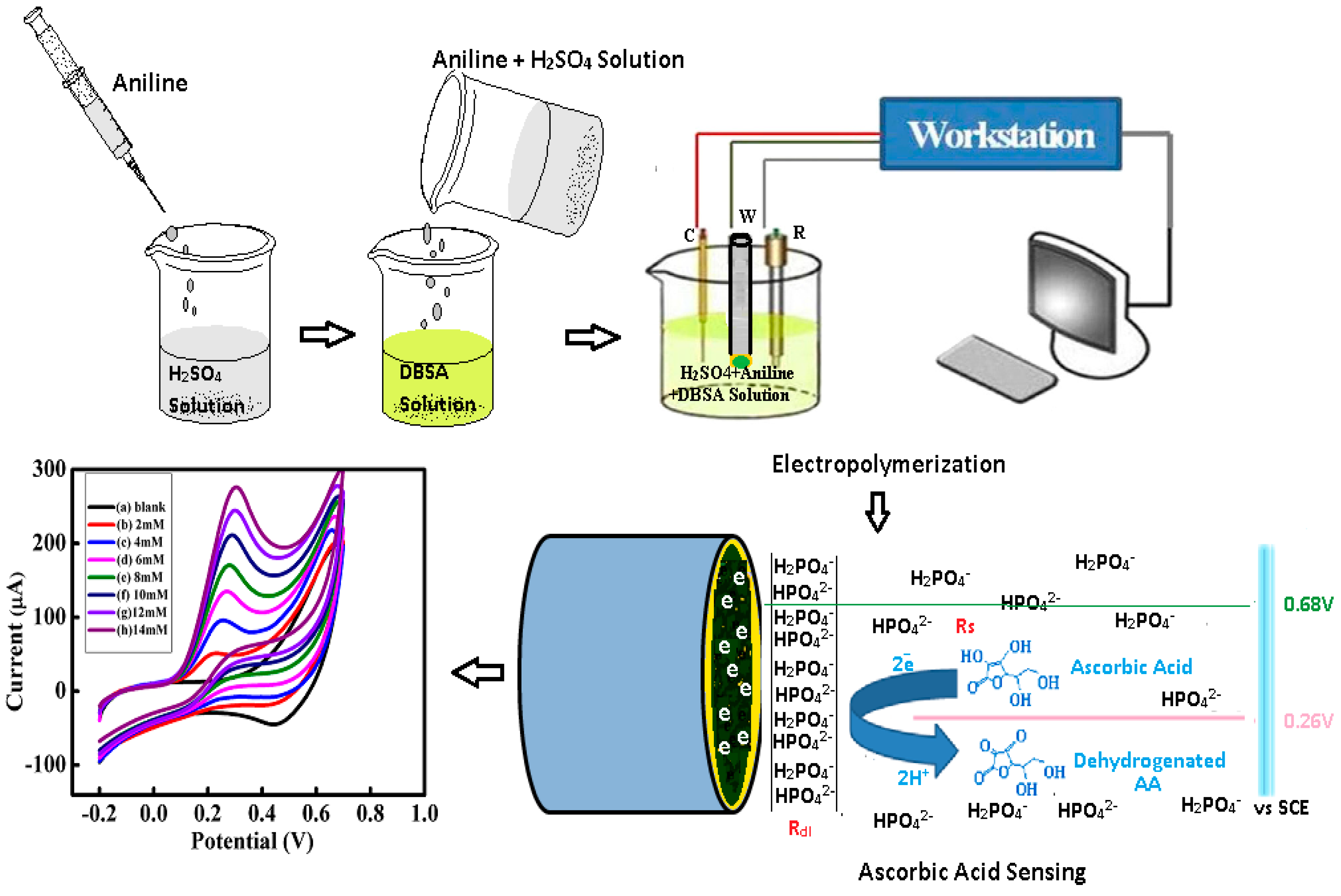

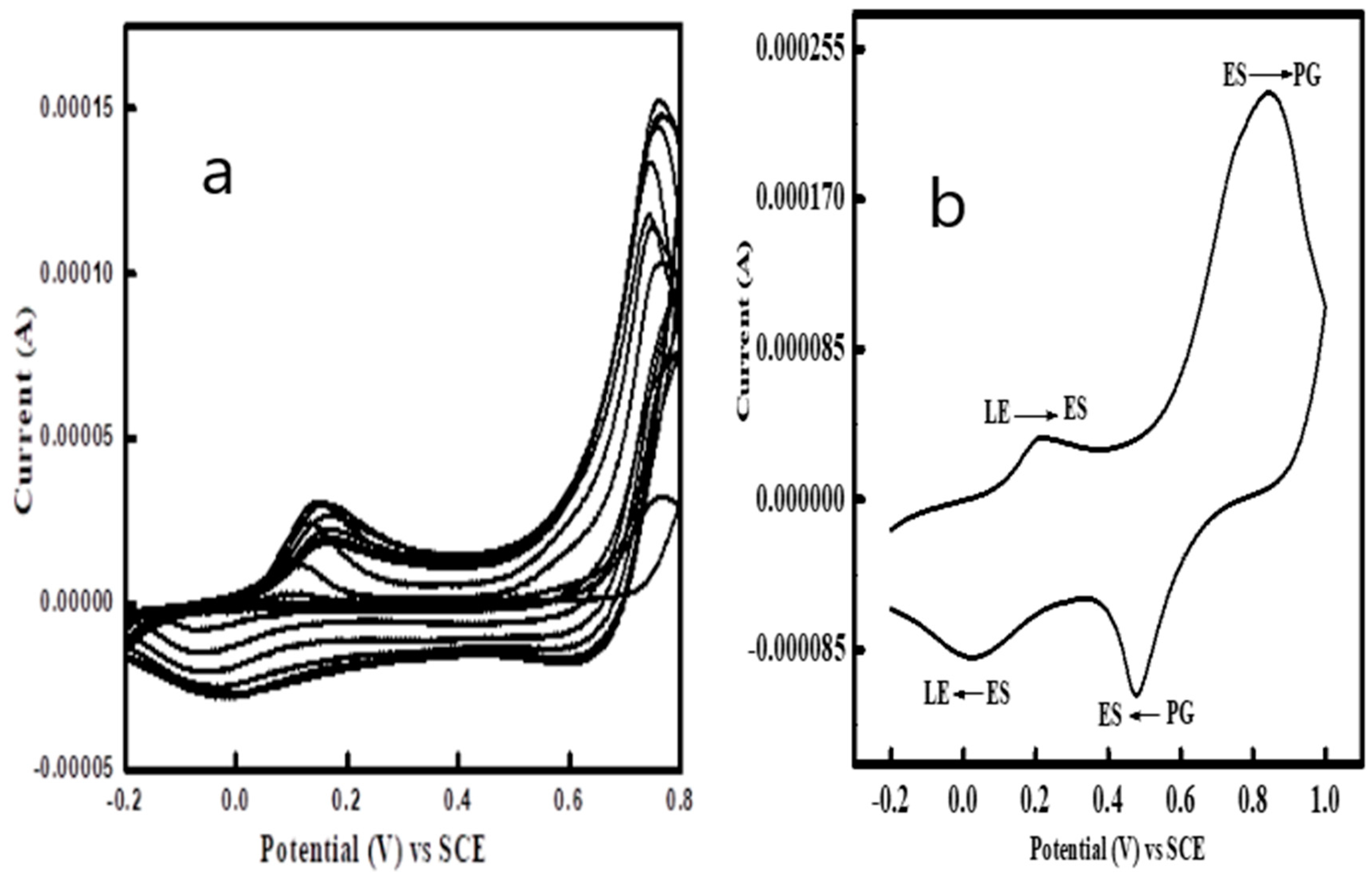


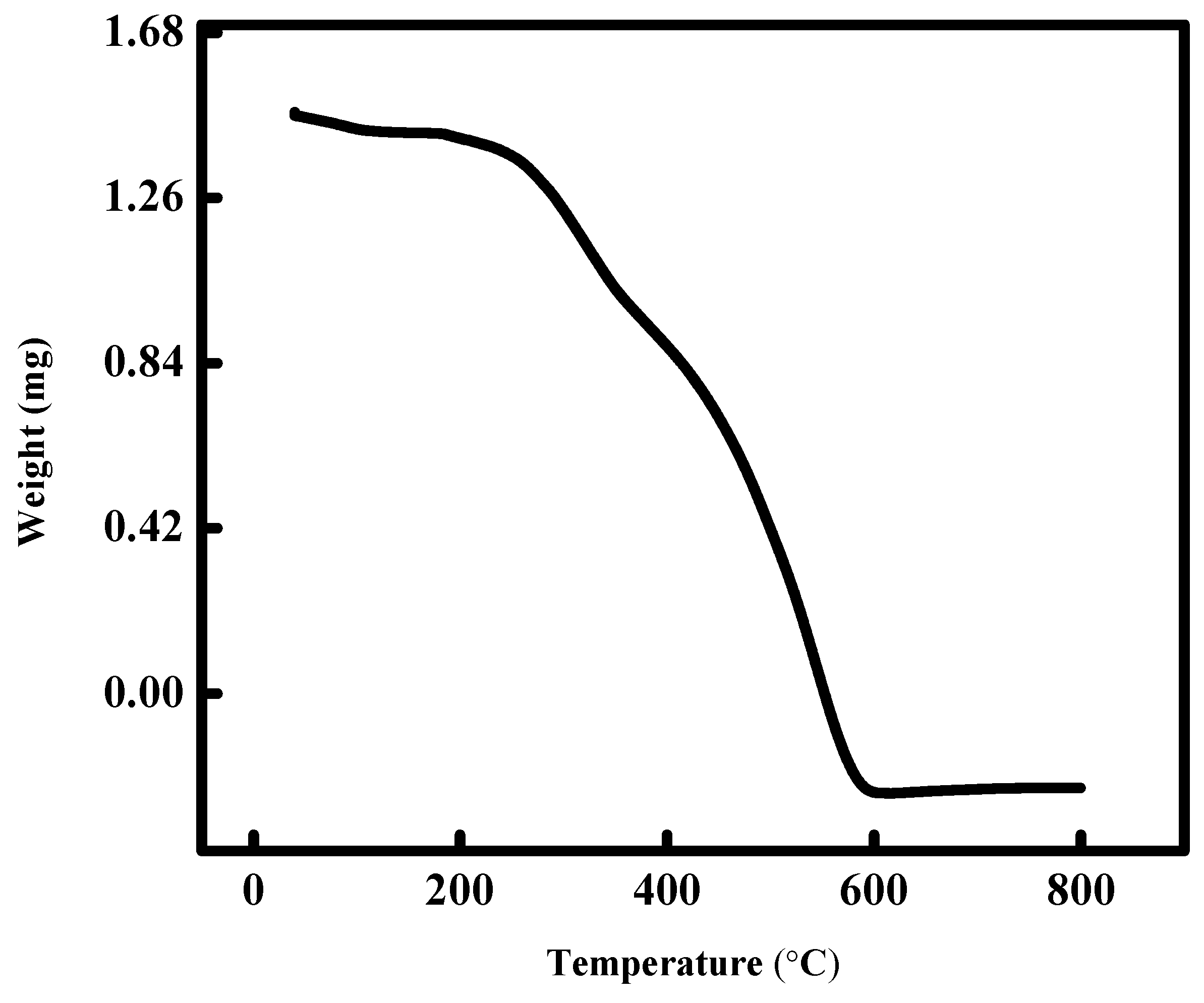



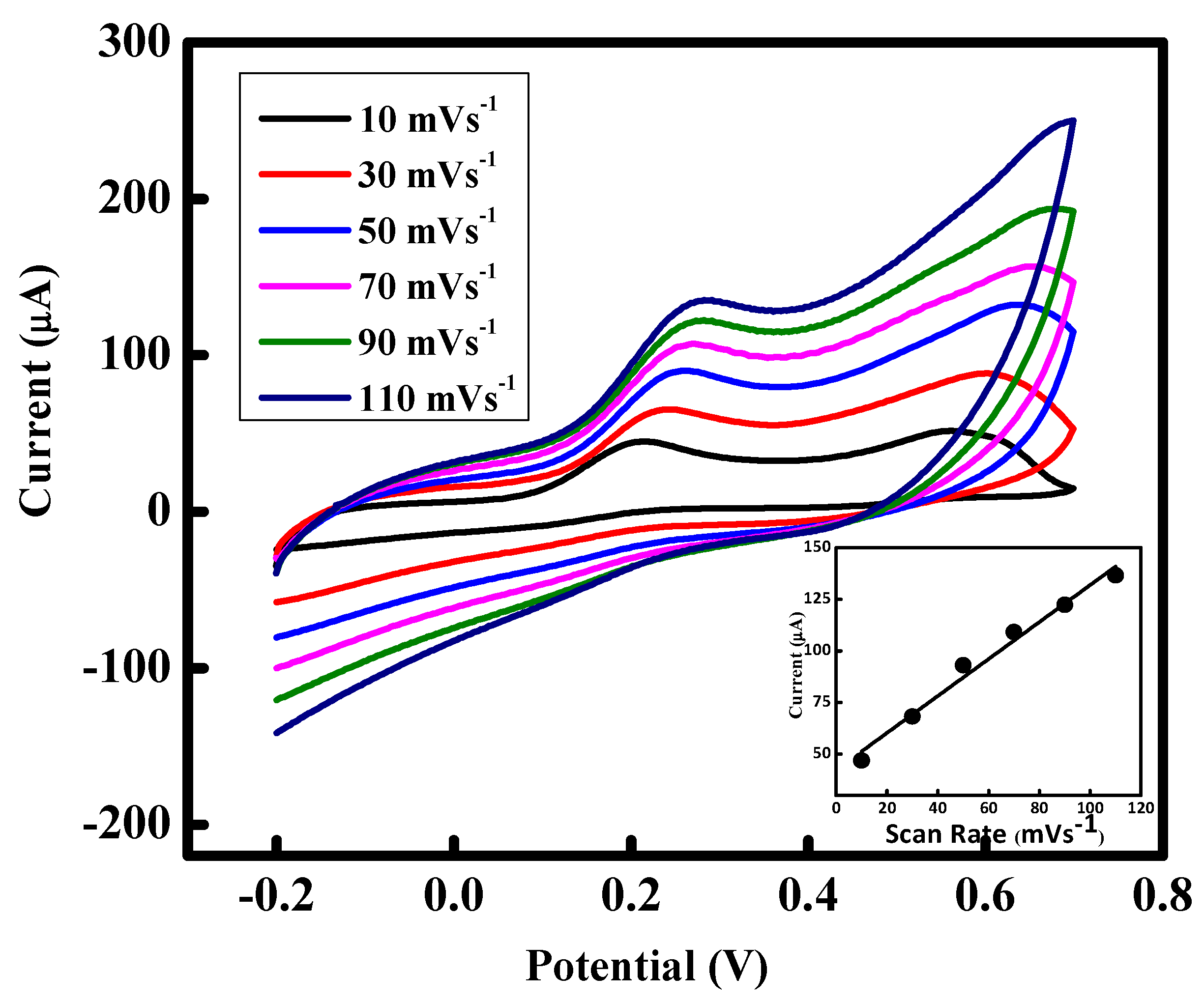

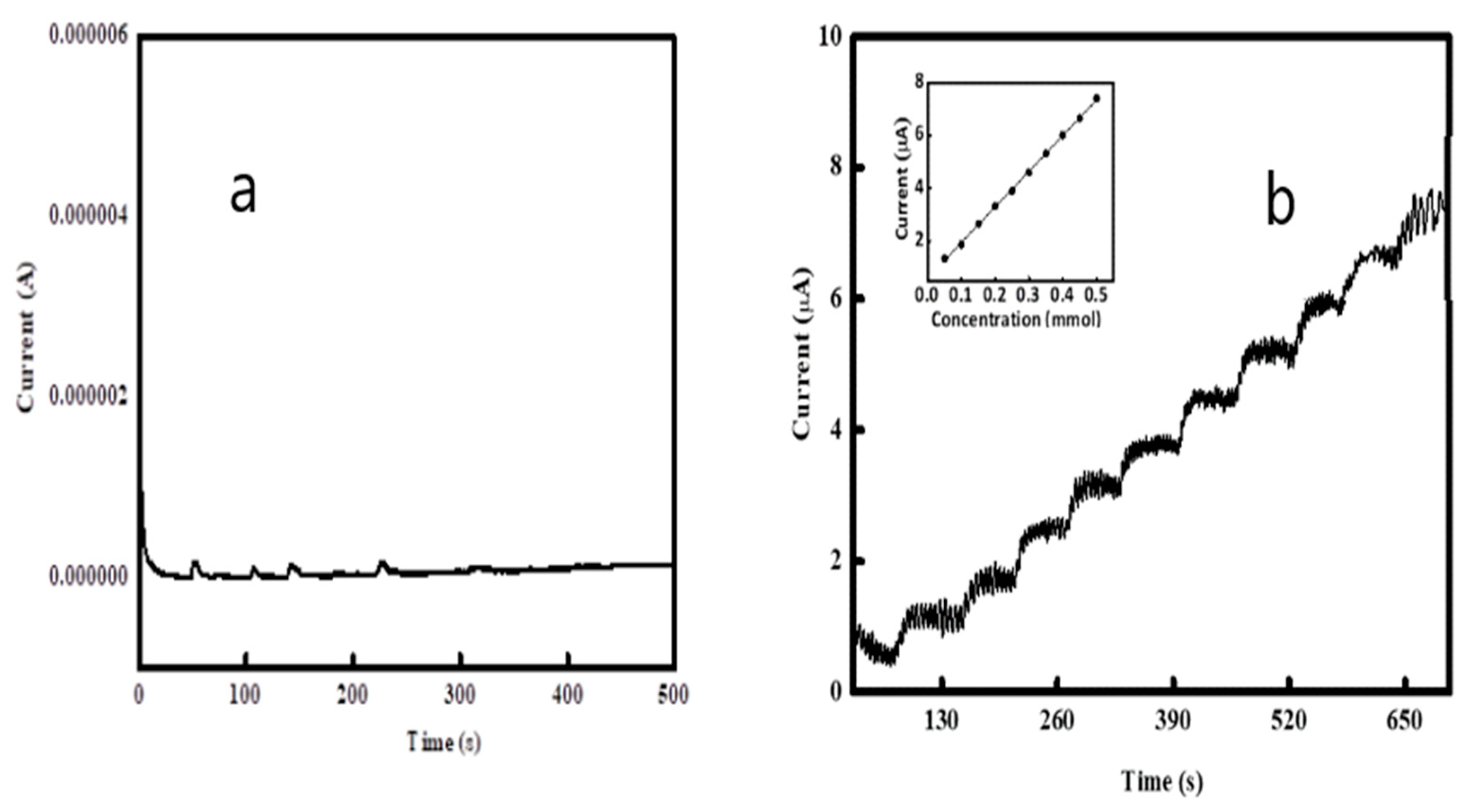
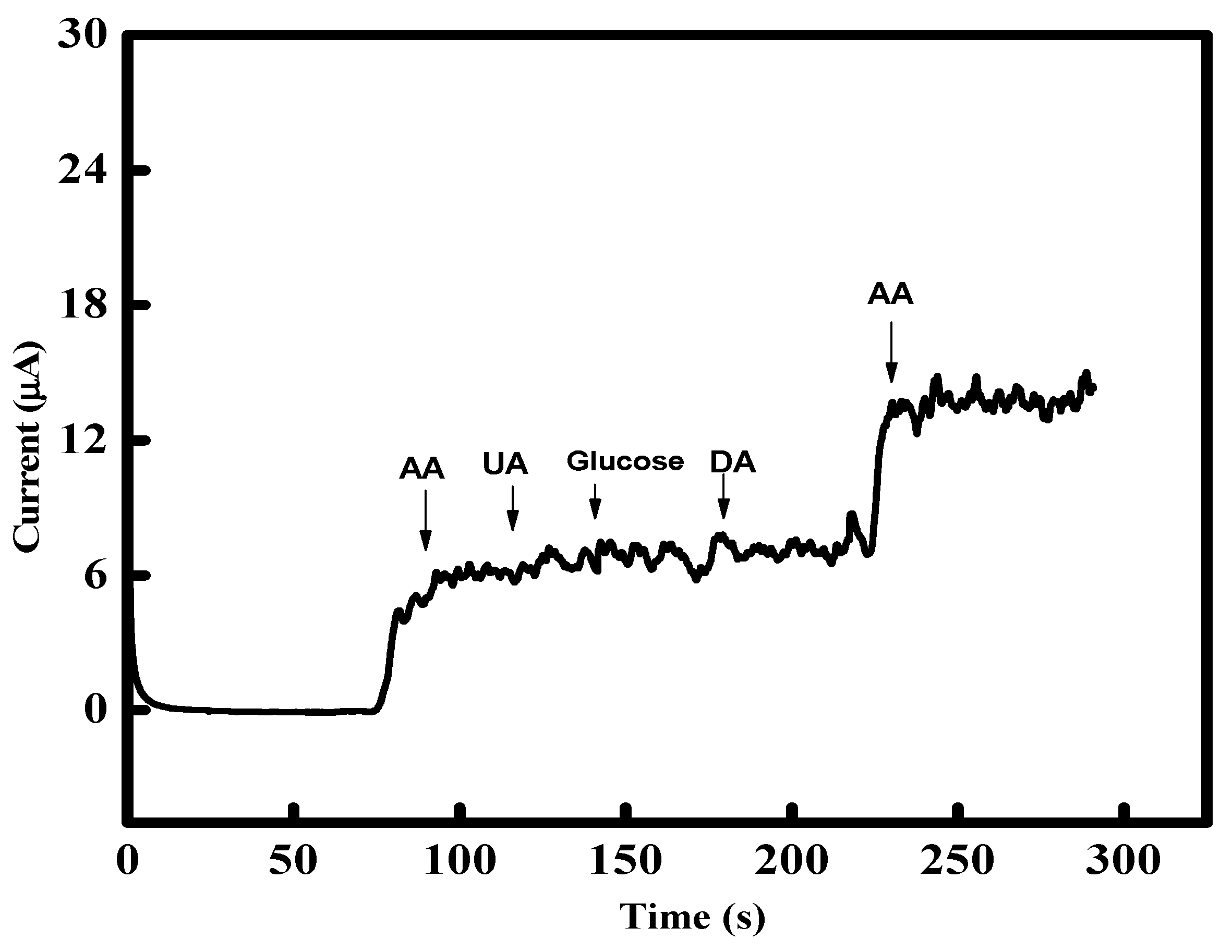
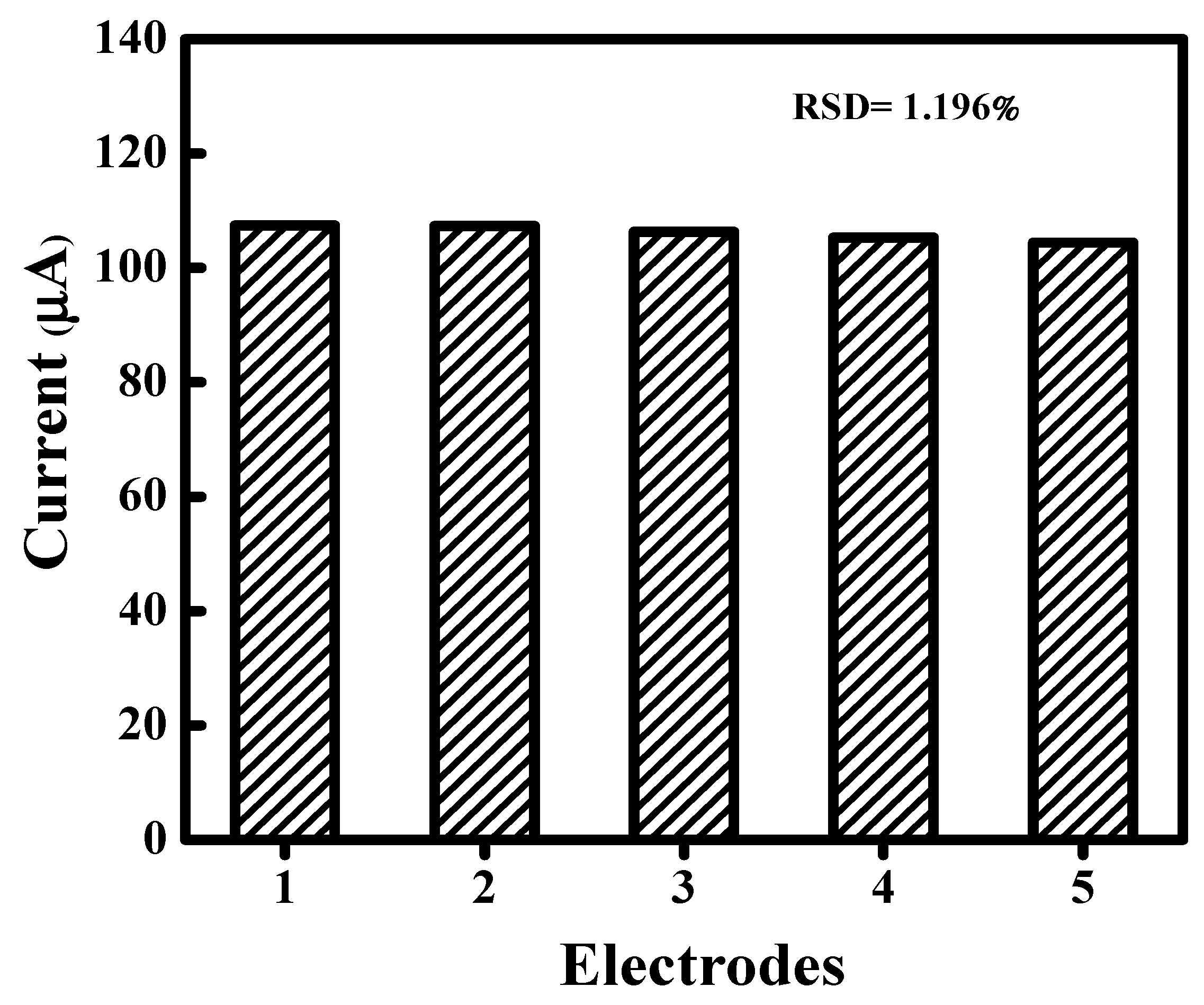
| Electrode | Linearity (mM) | LOD/(μmol·L–1) | Reference |
|---|---|---|---|
| Cu4(OH)6SO4 Nanorods | 0.017–6 | 6.4 | [46] |
| Fe3O4/r-GO/GC | 0.3–7.2 | 20 | [47] |
| Poly(DB71)/GC | 0.001–2 | 1 | [48] |
| MWNTs/MGF/GC | 0.1–6 | 18.28 | [49] |
| ZnO–GO/GC | 0.005–2 | 1.2 | [50] |
| (DBSA)-doped nanoPANI/SPCPE | 0.5–8 | 8.3 | [24] |
| PANI-FSA/PGE | 0.001–0.1 | 1 | [51] |
| DBSA and H2SO4 doped PANI / Au-disc | 0.05–0.5 | 0.0267 | This work |
| Electrode | 1 | 2 | 3 | 4 | 5 | Mean | SD | RSD (%) |
|---|---|---|---|---|---|---|---|---|
| Peak Current (µA) | 107.4 | 107.3 | 106.3 | 105.3 | 104.4 | 106.12 | 1.27 | 1.1964 |
© 2019 by the authors. Licensee MDPI, Basel, Switzerland. This article is an open access article distributed under the terms and conditions of the Creative Commons Attribution (CC BY) license (http://creativecommons.org/licenses/by/4.0/).
Share and Cite
Bilal, S.; Akbar, A.; Shah, A.-u.-H.A. Highly Selective and Reproducible Electrochemical Sensing of Ascorbic Acid Through a Conductive Polymer Coated Electrode. Polymers 2019, 11, 1346. https://doi.org/10.3390/polym11081346
Bilal S, Akbar A, Shah A-u-HA. Highly Selective and Reproducible Electrochemical Sensing of Ascorbic Acid Through a Conductive Polymer Coated Electrode. Polymers. 2019; 11(8):1346. https://doi.org/10.3390/polym11081346
Chicago/Turabian StyleBilal, Salma, Ayesha Akbar, and Anwar-ul-Haq Ali Shah. 2019. "Highly Selective and Reproducible Electrochemical Sensing of Ascorbic Acid Through a Conductive Polymer Coated Electrode" Polymers 11, no. 8: 1346. https://doi.org/10.3390/polym11081346
APA StyleBilal, S., Akbar, A., & Shah, A.-u.-H. A. (2019). Highly Selective and Reproducible Electrochemical Sensing of Ascorbic Acid Through a Conductive Polymer Coated Electrode. Polymers, 11(8), 1346. https://doi.org/10.3390/polym11081346








